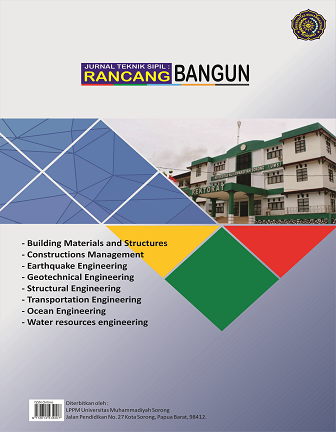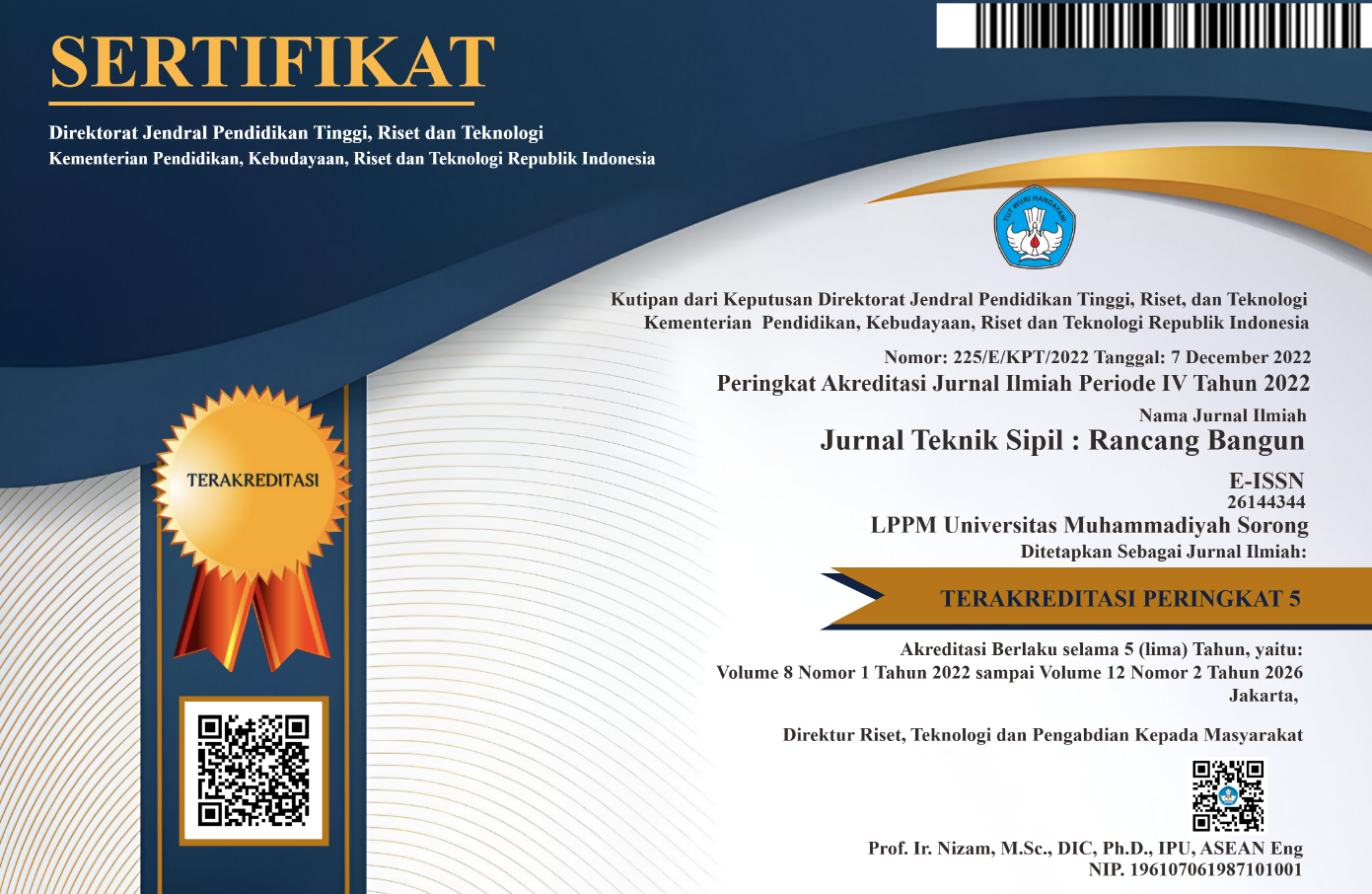PENGARUH TINGKAT KARBONASI TERHADAP KUAT TEKAN BETON PADA ASESMEN STRUKTUR GEDUNG EKSISTING
DOI:
https://doi.org/10.33506/rb.v10i1.3234Keywords:
beton inti, cepat rambat ultrasonik, karbonasi, palu pantulAbstract
Pada asesmen bangunan gedung dengan struktur utama beton bertulang, tentunya penentuan kuat tekan beton menjadi faktor utama dalam keakuratan hasil analisis. Uji kuat tekan pada beton inti adalah yang paling akurat, namun pada asesmen struktur gedung eksisting umumnya dibatasi karena faktor operasional gedung, sehingga harus dikombinasi dengan uji tidak merusak (non-destructive test, NDT). Pada gedung tua umumnya proses karbonasi sudah terjadi, dan ketika karbonasi sudah mencapai tulangan baja, akan menginisiasi korosi dan ini menjadi patologis utama pada beton bertulang. Penelitian dilakukan untuk mengetahui kuat tekan beton pada gedung sekolah 3 lantai yang berusia lebih dari 30 tahun, dengan mengambil 10 sampel beton inti yang dibarengi dengan NDT yaitu uji karbonasi, pengukuran cepat rambat gelombang ultrasonik (UPVT) dan palu pantul beton. Dan 30 titik uji lainnya tanpa sampling beton inti. Hasil penelitian menunjukkan kedalaman karbonasi justru meningkatkan kuat tekan dan mengurangi tingkat kesalahan dalam estimasi, dengan: dan =0,9241.
References
American Concrete Institute. (2019). ACI 228.1R-19 Report on Methods for Estimating In-Place Concrete Strength. American Concrete Institute.
Cahyono, T. (2015). Statistik Uji Normalitas (1st ed.). Yasamas.
Chen, Y., Liu, P., & Yu, Z. (2018). Effects of Environmental Factors on Concrete Carbonation Depth and Compressive Strength. Materials, 11(11), 2167. https://doi.org/10.3390/ma11112167
Choi, S.-J., Kim, Y.-U., Oh, T.-G., & Cho, B.-S. (2020). Compressive Strength, Chloride Ion Penetrability, and Carbonation Characteristic of Concrete with Mixed Slag Aggregate. Materials, 13(4), 940. https://doi.org/10.3390/ma13040940
Costa, R., Franchetto, A., Gouveia, A., Ziegler, F., Pessoa, K., & Garcez, M. (2022). Service life prediction for concrete structures based on carbonation front depth models. Revista Alconpat, 12(1), 47–60. https://doi.org/10.21041/ra.v12i1.558
Craeye, B., Renne, N., & De Maeijer, P. K. (2023). Effect of carbonation on non-destructive strength and durability assessment of limestone based concrete. International Conference on Non-Destructive Evaluation of Concrete in Nuclear Applications, 164–171.
IAEA. (2002). Guidebook on non-destructive testing of concrete structures. International Atomic Energy Agency.
Jena, T., & Panda, K. C. (2017). Compressive Strength and Carbonation of Sea Water Cured Blended Concrete. International Journal of Civil Engineering and Technology (IJCIET), 8(2), 153–162. http://iaeme.com/Home/journal/IJCIET153editor@iaeme.comhttp://iaeme.com/Home/issue/IJCIET?Volume=8&Issue=2http://iaeme.com
Khoeri, H. (2016). Non-Destructive Test Terhadap Semi Destructive Test pada Shear Wall Beton Bertulang. Konstruksia, 7(2). https://doi.org/https://doi.org/10.24853/jk.7.2.%25p
Matest. (2023). Matest Catalogue 2023 Material testing equipment (10th ed.). Matest.
Oktaviani, M. A., & Notobroto, H. B. (2014). Perbandingan Tingkat Konsistensi Normalitas Distribusi Metode Kolmogorov-Smirnov, Lilliefors, Shapiro-Wilk, dan Skewness-Kurtosis. Jurnal Biometrika Dan Kependudukan, 3(2), 127–135.
Olufemi, S. (2020). Effect of Carbonation on the Compressive Strength Development of Laterized Concrete. Civil and Environmental Research. https://doi.org/10.7176/cer/12-4-04
Paglia, C., Antonetti, S., & Mosca, C. (2022, May 21). The relationship between compressive strength and carbonation for in service concrete elements. Advanced Engineering and Technology.
Paglia, C., & Pader, M. (2024, February 12). Concrete with accelerated natural carbonated recycled cementitious aggregates. Pioneering the Emerging Trendsin Materials Science.
Pravalika, A., & Rao, V. (2018). Effect of Carbonation on the Properties of Concrete. International Journal of Civil Engineering and Technology (IJCIET), 9(7), 1606–1622. http://iaeme.com/Home/journal/IJCIET1605editor@iaeme.comhttp://iaeme.comhttp://iaeme.com
Proceq. (2022). Pundit PL200, Ultrasonic Pulse Velocity.
Ridho, F., & Khoeri, H. (2015). Perbandingan Mutu Beton Hasil Upvt Metode Indirect Terhadap Mutu Beton Hasil Hammer Test dan Core Drill. Konstruksia, 6(2). https://doi.org/10.24853/jk.6.2.%p
Shafiqah Ramlee, N., Hussein Abo Sabah, S., & Irwan Juki, M. (2021). Effect of Carbonation on Concrete Strength: A Systematic Review. Recent Trends in Civil Engineering and Built Environment, 2(1), 388–396. https://doi.org/10.30880/rtcebe.2021.02.01.018
Wadile, M., Joshi, Prof. H., & Pawar, Prof. R. (2023). A Review on Experimental Study to Reduce Carbonation Effect on Concrete. International Journal for Research in Applied Science and Engineering Technology, 11(2), 591–594. https://doi.org/10.22214/ijraset.2023.49099
Downloads
Published
How to Cite
Issue
Section
License
Copyright (c) 2024 Heri Khoeri

This work is licensed under a Creative Commons Attribution-ShareAlike 4.0 International License.






